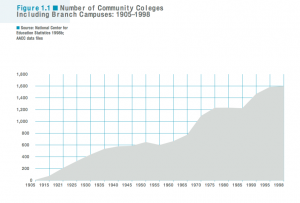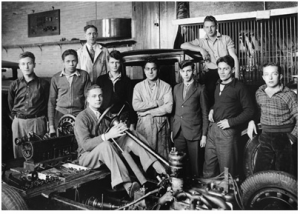Ed 300 Research Proposal
Research Question: How have U.S public schools changed their approach to educating children with disabilities since the Education for All Handicapped Children Act was enacted in 1975? How and why have the goals of special education changed over time?
Significance: Before 1975, the vast majority of students with disabilities received no formal education. However, the Education for all Handicapped Children Act of 1975 required all public schools accepting federal funds to provide disabled children with equal access to education. Since that time, the goals of educational programs for disabled students have evolved. Schools are now moving away from special education towards a policy of integration. There have been changes in teacher qualifications and training, stated objectives, and the overall approach to educating students with disabilities. This topic is relevant to ED 300 because it focuses on a major challenge that public schools in America face. The number of students diagnosed with some type of disability is growing at a rapid rate. When discussing proposals for education reform, it is often forgotten that these students do exist at public schools and must be taken into account in any reform strategy. I also have a personal interest in this topic as I have worked with teens with disabilities for several years. I am interested in learner what their experiences are like in the public school system and how that experience is different than it would have been at different points during the last three and a half decades.
Research Strategy: I searched google scholar for changes in special education policy and found a few promising results. However, these resources were not quite sufficient for a research paper. I then searched Education week’s database in search of articles from different time periods. I ran multiple searches of the database with each one focusing on a different five year period in order to uncover how the thinking about children with disabilities has changed over time (only goes back to 1981). I also used the TOR library resources and searched for relevant books in the Library catalog. A search for old newspaper articles was surprisingly not very successful. I plan on trying to find official curricula for disabled students from different eras but I am not sure where I can find this.
Sources
Biklen, Douglas. “After 10 Years of Mainstreaming: The Disabled Are Making Impressive Gains.” Education
Week, April 27, 1983. http://www.edweek.org/ew/articles/1983/04/27/03170001.h02.html?qs=disabilities.
Council for Exceptional Children. Teacher Education and Special Education. Reston, Va: Teacher Education Division of the Council for Exceptional Children, 1977.
DuBois, Stephen. “13 Percent of Oregon Student Population – Nearly 85,000 – in Special Education Programs | The Republic.” The Republic, n.d. http://www.therepublic.com/view/story/b250248422f64c1aa44dd788a55bf1ae/OR–Special-Education/.
Flanagan, Nancy. “Moving Special Education to the Virtual World.” Education Week – Teacher in a Strange Land, n.d. http://blogs.edweek.org/teachers/teacher_in_a_strange_land/2010/08/moving_special_education_to_the_virtual_world.html?cmp=SOC-SHR-FB.
Foster, Susan G. “‘Mainstreaming’ Still A Problem in Special Education.” Education Week, March 2, 1983. http://www.edweek.org/ew/articles/1983/03/02/03100018.h02.html?qs=special+education.
Hyman, Irwin A., and Richard Roeder. “The Dumbing of Special Education.” Education Week, May 26, 1993. http://www.edweek.org/ew/articles/1993/05/26/35hyman.h12.html?qs=disabilities.
Reese, Phillip, and Melody Gutierrez. “Budget Cuts, Change in Approach Place More Special Education Students in Regular Schools – The Sacramento Bee.” The Sacramento Bee, n.d. http://www.sacbee.com/2012/04/04/4389390/budget-cuts-change-in-approach.html.
Richardson, John G., and Tara L. Parker. “The Institutional Genesis of Special Education: The American Case.” American Journal of Education 101, no. 4 (1993): 359–392.
SCHEMO, Diana. “House Backs Vast Changes In Education For Disabled – New York Times”, n.d. http://www.nytimes.com/2003/05/01/us/house-backs-vast-changes-in-education-for-disabled.html.
Schnaiberg, Lynn. “E.D. Report Documents ‘Full Inclusion’ Trend.” Education Week, October 19, 1994. http://www.edweek.org/ew/articles/1994/10/19/07idea.h14.html?qs=disabilities.
Shah, Nirvi. “S.C.’s Penalty for Cutting Special Ed. Spending Delayed.” Education Week – On Special Education, n.d. http://blogs.edweek.org/edweek/speced/2011/08/south_carolina_penalty_for_cut.html?cmp=SOC-SHR-FB.
Shah, Nirvi. “New Research Projects Explore Ways to Improve Special Education.” Education Week – On Special Education, n.d. http://blogs.edweek.org/edweek/speced/2012/03/more_than_two_dozen_research.html?cmp=SOC-SHR-FB.
Singer, Judith, and John Butler. “The Education for All Handicapped Children Act: Schools as Agents of Social Reform.” Harvard Educational Review 57, no. 2 (July 1, 1987): 125–153.
———. “The Education for All Handicapped Children Act: Schools as Agents of Social Reform.” Harvard Educational Review 57, no. 2 (July 1, 1987): 125–153.
Skiba, Russell, Ada Simmons, Shana Ritter, Ashley Gibb, M. Rausch, Jason Cuadrado, and Choong-Geun Chung. “Achieving Equity in Special Education: History, Status, and Current Challenges.” Exceptional Children 74, no. 3 (January 1, 2008): 264–288.
United States. Accountability and IDEA: What Happens When the Bus Doesn’t Come Anymore?: Hearing Before the Committee on Health, Education, Labor, and Pensions, United States Senate, One Hundred Seventh Congress, Second Session, Examining the Implementation of the Individuals with Disabilities Education Act, Focusing on Accountability from the Federal Government, and a Collaboration Between Institutions of Higher Education, Local Schools, and School Faculties for Teacher Preparation Programs, June 6, 2002. S. Hrg 107-672. Washington: U.S. G.P.O. : For sale by the Supt. of Docs., U.S. G.P.O., [Congressional Sales Office], 2002.
———. Progress Toward a Free Appropriate Public Education; a Report to Congress on the Implementation of Public Law 94-142: The Education for All Handicapped Children Act. DHEW Publication (OE). Washington: U.S. Dept. of Health, Education, and Welfare, [Education Division], U.S. Office of Education, 1979.
United States, and United States. Annual Report to Congress on the Implementation of Public Law 94-142, the Education for All Handicapped Children Act. Washington, D.C.: U.S. Dept. of Education, U.S. Office of Special Education and Rehabilitatative Services, 1980.
Viadero, Debra. “Students With Disabilities Are Overlooked In Push To Measure Skills.” Education Week, March 4, 1992. http://www.edweek.org/ew/articles/1992/03/04/24speced.h11.html?qs=disabilities.
Yell, Mitchell L, David Rogers, and Elisabeth Lodge Rogers. “The Legal History of Special Education What a Long, Strange Trip It’s Been!” Remedial and Special Education 19, no. 4 (July 1, 1998): 219–228.

